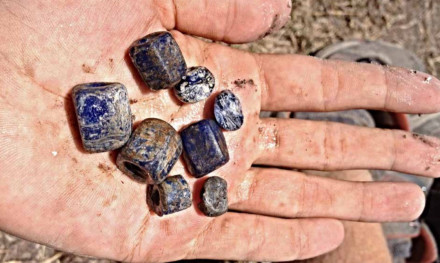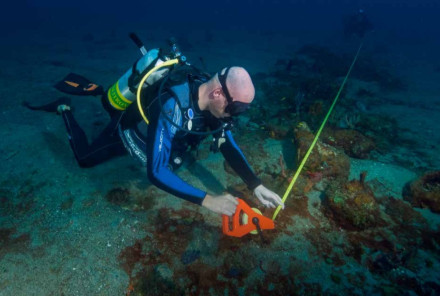History
Blue beads
During the eighteenth century, the free port of Sint Eustatius caused thousands of ships to drop anchor in the now historic roadstead. Today, ship and artifact remains from this busy era litter the sea floor. In order to fully understand the shipwrecks of Sint Eustatius, one must first understand an important part of their cargo, the blue bead. Large amounts of blue glass beads have been found not only on Sint Eustatius but throughout colonial-period archaeological sites in the Atlantic World. Among their many uses and meanings, these beads were often traded for enslaved people in West Africa.
Plain blue seems to have been the preferred bead color in the Caribbean. On Sint Eustatius, one particular type of blue glass bead predominates. It was classified as the WIIf*(d) type by researchers Karklins and Barka (Karklins & Barka 1989). Beads of this type are dark blue and pentagonal in cross-section. Made in Amsterdam by Venetian glassblowers as early at the first half of the seventeenth century, they are of the wound bead type, made by winding a strand of molten glass around a rotating metal mandrel until the desired size and shape were achieved (Karklins 1974, p. 67).

While beads of the WIIf*(d) type have also been found in colonial-period Native American sites in North America and slave trading posts in West Africa, they only occur in such large quantities on Sint Eustatius. During the 1981-1987 field seasons on Sint Eustatius, archaeologists from the College of William & Mary recovered 325 beads from various terrestrial excavations, 25 percent of which were beads of the WIIf*(d) type. These beads are found all over the island, but particularly on the beach in Gallows Bay. This suggest that this particular type was either especially popular with the local population or that Statia (the nickname of the island) was a major distribution point for them (Karklins & Barka 1989, p. 67). It is said that these ‘Statia blue beads’ were used as a type of currency by the enslaved population and were worn as body ornaments on necks, arms, and legs. Bead use among enslaved people throughout the Caribbean seems to have been widespread according to many historical sources (Karklins & Barka 1989, p. 75). They were acquired by trading, stealing, or as gifts. One local legend has it that when enslaved people on Statia were emancipated on July 1, 1863, they stood on the edge of the cliffs and threw their beads into the sea as a sign of their freedom.
Blue Bead Hole
In 1907, Frederick A. Fenger sailed from Grenada to St. Thomas in a 5.2 meter long canoe, stopping on many islands along the way, including Sint Eustatius. He published the book 'Alone in the Caribbean', describing his adventures and thus providing information about Sint Eustatius as well. Fenger described a shipwreck containing thousands of blue beads which also happens to be at a popular dive site called Blue Bead Hole, located a few hundred meters west of the harbor in Gallows Bay. Here, divers often find blue beads of the WIIf*(d) type which they can take home as souvenirs. Over the last three decades, thousands of blue beads have been found in this area. They are usually found after heavy swells which cause the sandy bottom to stir up, thereby exposing beads that were previously buried. The area where the blue beads are found is a few hundred meters across, but most are found in a very small area that contains a large concentration of beads. It is in this small area where the ship described by Fenger must have sunk. The loss of a cargo of blue beads is the only logical explanation for their abundance in this area, as the legend whereby former enslaved people threw their beads into the sea at emancipation does not account for the large numbers of beads that are found here. Moreover, they could not have thrown their beads that far into the sea, as the site is located several hundred meters from shore. In this case, an oral historical account of the island’s inhabitants about the wrecking of a ship told to and written down by Fenger provides an explanation for the presence of large numbers of blue beads in this area.
Blue Bead Hole consists of a sandy sea floor, ranging from 15 to 17 meters deep. Despite the fact that many – undoubtedly the most intact and most visually appealing – artefacts have been looted from this site over the past 30 years, an abundance of artefacts besides the famed blue beads is still found here, including ceramic fragments, glass bottle fragments, ballast bricks, and metal artefacts. There is said to be a swivel gun present at the deeper part of the site as well, but it was not found during a survey conducted in 2015 by the St. Eustatius Center for Archaeological Research. The site is also covered in ballast stones, indicating that many ships anchored in this area. The ballast stones are scattered across the site, with concentrations at various locations. One of the largest concentrations is located near the center of the site, where most blue beads have been found. The stones appear in small piles across the sandy sea floor, some of which are up to eight meters long and half a meter high. It is possible that some of these larger piles may be the remains of shipwrecks instead of ballast that was thrown overboard, but this is impossible to determine without excavating underneath the structures. It could be that only the tops of these piles are visible, as the depth of the site can be reduced or increased by several meters due to erosion and sedimentation of sand caused by storms. Despite the fact that many artifacts and ballast stones were encountered, it was impossible to link any of these, except for the blue beads, to the Blue Bead wreck. Shipwreck remains in Sint Eustatius are given numbers starting with SE. The concentration of blue beads, which marks the (approximate) location where the ship sank, was named SE-506.

It is interesting to note that the cargo of blue beads ended up on Sint Eustatius in the first place. As the examples above demonstrate, slave trade beads were mainly used to purchase enslaved in West Africa, but they remained part of ships’ cargoes in the New World. The fact that such large quantities are now found on Statia indicates that the ship carrying them may have been involved in the slave trade and had the intention of trading the beads in West Africa at a later date. This is mentioned by Fenger as well, who heard this story from people on the island. It may also be that these beads, which are all the same type, were shipped to Statia specifically because they were so commonly used by the island’s (enslaved) population. Considering the fact that the cargo was of such homogenous nature, particularly compared to that of the Bermudian Debris site, this is a plausible scenario. Whatever the reason is for their presence on Statia, the large numbers of beads found on the sites discussed above indicates that there may still be thousands of beads left on the Blue Bead wreck site.
Description
References
- Frederick A. Fenger (1917).
Alone in the Caribbean. Being the yarn of a cruise in the Lesser Antilles in the sailing canoe Yakaboo.
United States of America. - Karlis Karklins (1974).
Seventeenth Century Dutch Beads.
Historical Archaeology, vol. (8).
pp 64-82. - Karlis Karlins, Norman F. Barka (1989).
The Beads of St. Eustatius, Netherlands Antilles.
Beads – Journal of the Society of Bead Researchers. - Ruud Stelten (2019).
From Golden Rock to Historic Gem: A Historical Archaeological Analysis of the Maritime Cultural Landscape of St. Eustatius Dutch Caribbean.
Leiden: Sidestone Press.